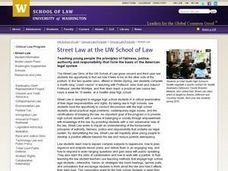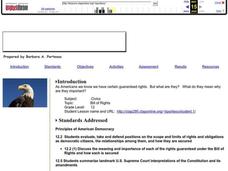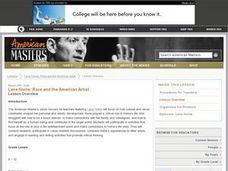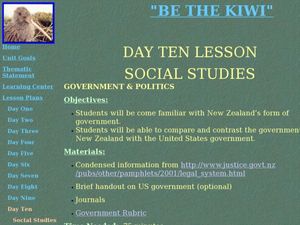C-SPAN
Choice Board: Expressed and Implied Powers
Article 1, Section 8 of the United States Constitution expressly lists powers given to Congress. Over the years, lawmakers have expanded the enumerated powers to include powers implied by the list. To better understand the significance...
Curated OER
Introduction to the Constitution: The First Three Articles of the Constitution, Separation of Powers
High schoolers review the first three articles of the United States Constitution. In groups, they examine the three branches of government and their function. They follow the path of a bill until it becomes law and discuss Congress' role.
Curated OER
The "Big Four"
Students identify the four individuals who are identified as the "Big Four", examine the years they were on the bench together, and look and the impact they made in key cases.
Curated OER
From Tinker to Fraser: Freedom of Speech in Public Schools
The Tinker and Fraser cases were taken the Supreme Court on the basis of the 1st Amendment right to Freedom of Speech. Learners discuss each case, the First AMendment, complete handouts, and conduct a role play activity. Handouts are...
Curated OER
Introduction to the History of the Michigan Supreme Court
Pupils identify the players, events and changes in the history of the Supreme Court of Michigan. They explain the purpose of the Court in state government. They summarize the role and purpose of the Court.
Curated OER
The Legacy of the Warren Court
Students examine the major decisions by the Supreme Court when Warren was the Chief Justice. In groups, they research the life and other works of Earl Warren and discuss how ones background can influence decisions. They also examine...
Curated OER
Bill of Rights
Twelfth graders list, describe, and illustrate the specific rights guaranteed to individuals and how they are secured. Then they examine landmark Supreme Court cases, such as, Airport Commissioner vs. Jews for Jesus, New Jersey vs. TLO,...
Curated OER
Michigan Court System (Part 1) (Middle School)
Students identify the courts that make up the Michigan judicial system. They explore the responsibility of each court and diagram how cases move to the Supreme Court. They compare and contrast the different types of courts.
Curated OER
In Search of Rights
Seventh graders research Supreme Court cases. They formally debate court rulings, write a scenario portraying a possible futuristic America and participate in a field practicum for media production, while evaluating various social,...
Curated OER
The Supreme Court
Students examine the Fourteenth Amendment. In this Supreme Court lesson, students define due process and equal protection as they analyze the impact of the amendment and the Supreme Court on workers' rights in the early 20th century....
Curated OER
Eminent Domain: Should Private Property Be Taken for Public Use?
Students explore the concept of eminent domain. In this eminent domain lesson, students analyze positive and negative consequences of Supreme Court rulings in three cases pertaining to the public good.
Curated OER
History of the Michigan Supreme Court from the Territorial Court and the founding of the Michigan Supreme Court in 1836 to Justice Mary S. Coleman and her interpretation of "One Court of Justice"
Students trace the history of the Michigan Supreme Court from when the state was still a territory. They define procedures as they relate to the Court. They compare and contrast the territorial court to the new Court.
Curated OER
Brown v. Board of Education of Topeka
Twelfth graders explore desegregation as it occurred at various stages in United States history. They specifically chronicle the role of South Carolina in the desegregation case of Brown v. Board of Education.
Curated OER
Lena Horne: Race and the American Artist
Young scholars examine how race played a critical role in Lena Horne's life. They conduct Internet research, participate in a class debate, write a letter, and create a presentation based on their Internet research.
Curated OER
Be the Kiwi: Government and Politics in New Zealand
Students examine the structure of government in New Zealand. In this government instructional activity, students listen their instructor present information about the government in New Zealand then create diagrams that compare its...
















